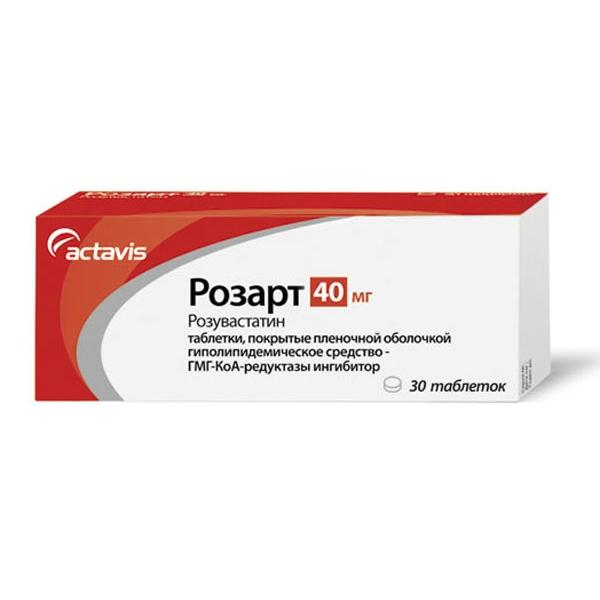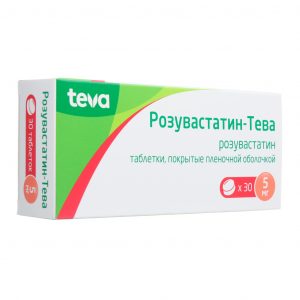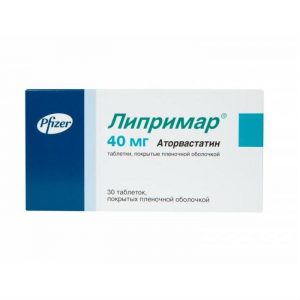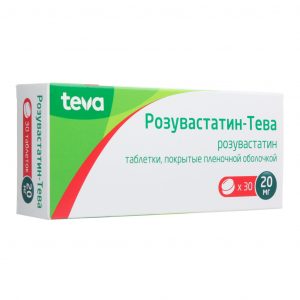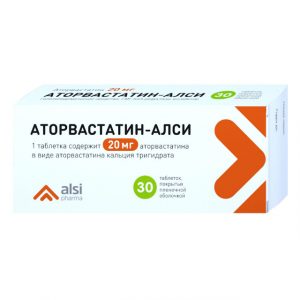Description
Release form
tablets
packaging 30 pcs
Indications
Primary hypercholesterolemia (type IIa according to Fredrickson), including heterozygous hereditary hypercholesterolemia) or mixed (combined) hyperlipidemia (type IIb according to Fredrickson), as an addition to diet and other non-drug measures (physical activity and weight loss)
Homozygous form of hereditary hypercholesterolemia with insufficient effectiveness of diet therapy and other types of treatment aimed at lowering lipids (for example, LDL apheresis) or, if such treatments are not fit the patient.
Hypertriglyceridemia (type IV Fredrickson supplementation) as a diet supplement.
To slow the progression of atherosclerosis as a supplement to the diet in patients who are shown therapy to lower total cholesterol and LDL cholesterol.
Prevention of major cardiovascular complications (stroke, heart attack, arterial revascularization) in adult patients without clinical signs of coronary heart disease (CHD), but with an increased risk of its development (age over 50 for men and over 60 for women, increased concentration of C-reactive protein ( 2 mg / l) in the presence of at least one of the additional risk factors, such as arterial hypertension, low concentration of HDL cholesterol, smoking, family history of early onset of coronary heart disease).
Contraindications
Hypersensitivity to rosuvastatin or other components of the
preparation Liver diseases in the active phase, including a persistent increase in serum activity of “liver” transaminases (more than 3 times compared with the upper limit of the norm (VGN)) of unclear genesis of srdlp function kidney (CC less than 30 ml / min)
Myopathy
Concomitant use of cyclosporine
Women of reproductive age, not using adequate contraceptive methods
Pregnancy and lactation
Age up to 18 years (efficacy and safety not established)
Lactose intolerance, lactase deficiency, glucose-galactose malabsorption (the drug contains lactose monohydrate).
The presence of the following risk factors for the development of myopathy / rhabdomyolysis: – Myotoxicity with the use of other inhibitors of HMG-CoA reductase or fibrates with a history of
– Hypothyroidism
– Renal failure of moderate severity (CC less than 60 ml / min)
– Excess – Conditions that can lead to an increase in plasma concentration of rosuvastatin
– Simultaneous administration of
fibrates Patients of the Mongoloid race
Family history of muscle diseases.
Caution: The presence of risk factors for the development of myopathy and / or rhabdomyolysis – renal failure (CC more than 30 ml / min), hypothyroidism, personal or family history of hereditary muscle diseases and a previous history of myotoxicity with other HMG-CoA reductase inhibitors or fibrates excessive alcohol consumption, age older than 70 years of a condition in which there is an increase in the plasma concentration of rosuvastatin race (Mongoloid race), simultaneous use with fibrates, a history of liver disease, with epsis, arterial hypotension, extensive surgery, trauma, severe metabolic, endocrine or electrolyte disturbances or uncontrolled epilepsy.
Renal failure (CC more than 60 ml / min).
There is no experience with the use of the drug in patients with impaired liver function (9 or more on the Child-Pugh scale).
Use during pregnancy and lactation
Rosart is contraindicated in pregnancy and lactation.
The use of Rosart in women of reproductive age is possible only if reliable methods of contraception are used and if the patient is informed about the possible risk of treatment for the fetus.
Since cholesterol and substances synthesized from cholesterol are important for fetal development, the potential risk of inhibiting HMG-CoA reductase exceeds the benefits of using the drug during pregnancy. In the case of diagnosing pregnancy during therapy with Rosart, the drug should be stopped immediately, and patients should be warned of the potential risk to the fetus.
Data on the allocation of rosuvastatin with breast milk are not available, therefore, if necessary, use the drug during lactation, given the possibility of adverse events in infants, the question of stopping breastfeeding should be decided.
Composition of
1 tablet contains:
Active ingredient: rosuvastatin 40 mg
Excipients: microcrystalline cellulose, type 102, crospovidone, type A, calcium hydrogen phosphate dihydrate, lactose monohydrate, magnesium stearate white pla titanium dioxide, lactose monohydrate, macrogol-3350, triacetin).
Dosage and administration
Inside, without chewing or grinding, swallow whole, washed down with water, at any time of the day, regardless of food intake.
Before starting therapy with Rosart, the patient should begin to follow a standard lipid-lowering diet and continue to follow it during treatment. The dose of the drug should be selected individually depending on the indications and therapeutic response, taking into account current generally accepted recommendations for target lipid levels. The recommended initial dose of Rosart for patients starting to take the drug, or for patients transferred from taking other HMG-CoA reductase inhibitors, is 5 or 10 mg 1 time / day. When choosing an initial dose, one should be guided by the patient’s cholesterol content and take into account the risk of developing cardiovascular complications, and it is also necessary to assess the potential risk of side effects. If necessary, after 4 weeks the dose of the drug can be increased.
Due to the possible development of side effects when taking a dose of 40 mg compared with lower doses of the drug (see section “Side effects”), final titration to a maximum dose of 40 mg should be carried out only in patients with severe hypercholesterolemia and a high risk of cardiovascular complications (especially in patients with hereditary hypercholesterolemia) who, when taking a dose of 20 mg, did not achieve the target cholesterol level, and who will be under medical supervision.
Especially careful monitoring of patients receiving the drug in a dose of 40 mg is recommended. After 2-4 weeks of therapy and / or increasing the dose of the drug, monitoring of lipid metabolism is necessary.
Dose adjustment is not required in elderly patients.
In patients with hepatic insufficiency on a Child-Pugh scale below 7, dose adjustment is not required. In patients with values of 8 and 9 on the Child-Pugh scale, a preliminary assessment of renal function should be performed. There is no experience with the use of rosuvastatin in patients with liver failure above 9 points on the Child-Pugh scale.
Dosage adjustment is not required for mild or moderate renal failure. An initial dose of 5 mg is recommended for patients with moderate renal failure (CC less than 60 ml / min). In patients with moderate renal failure (CC less than 30-60 ml / min), a dose of 40 mg is contraindicated. Taking Rosart is contraindicated in all doses to patients with severe renal failure (CC less than 30 ml / min).
Ethnic groups
In patients of the Asian race, an increase in the systemic concentration of rosuvastatin is possible. When prescribing doses of 10 and 20 mg, the initial recommended dose for patients of Asian origin is 5 mg. The use of the drug in a dose of 40 mg is contraindicated in such patients.
Patients predisposed to the development of myopathy
When prescribing doses of 10 and 20 mg, the initial recommended dose for such patients is 5 mg. The use of the drug in a dose of 40 mg in such patients is contraindicated.
Side effects
From the central nervous system: often – headache, dizziness, asthenic syndrome infrequently – depression, anxiety, insomnia, paresthesia very rarely – peripheral neuropathy, memory loss.
From the digestive system: often – nausea, constipation, abdominal pain infrequently – vomiting, diarrhea, flatulence is rare – pancreatitis is very rare – hepatitis, jaundice.
From the respiratory system: often – pharyngitis infrequently – rhinitis, sinusitis, bronchial asthma, bronchitis, cough, dyspnea, pneumonia.
From the cardiovascular system: infrequently – angina pectoris, increased blood pressure, palpitations, vasodilation.
From the endocrine system: often – diabetes 1. (The overall frequency of 2.8% in the rosuvastatin group and 2.3% in the placebo group, mainly in patients with fasting glucose of 5.6 – 6.9 mmol / l, was reported in the JUPITER study.
From the musculoskeletal system: often – myalgia rarely – arthralgia myopathy (including myositis), rhabdomyolysis, back pain, muscle hypertonicity, pathological fracture of the extremities is very rare – immune-mediated necrotizing myopathy.
Allergic reactions: infrequently – skin itching, rash, urticaria, rarely – angioedema.
Skin and subcutaneous tissue: frequency unknown – Stevens-Johnson syndrome.
From the urinary system: often – proteinuria (mainly in patients receiving a dose of 40 mg), decreasing during therapy and not associated with the occurrence of kidney disease, urinary tract infections infrequently – peripheral edema, pain in the lower abdomen is very rare – hematuria.
Laboratory indicators: infrequently – a transient dose-dependent increase in serum creatine phosphokinase (CPK) activity, with an increase of more than 5 times compared with VGN, therapy should be temporarily suspended rarely – a transient increase in the activity of aspartate aminotransferase and alanine aminotransferase.
Other: often – back pain, rhinopharyngitis rarely – decreased potency.
As with other HMG-CoA reductase inhibitors, the incidence is dose-dependent, side effects are usually mild and go away on their own.
overdose
Treatment: no specific treatment, symptomatic therapy under the control of liver function and CPK activity. Hemodialysis is ineffective.
Storage Conditions
No special storage conditions required. Keep out of reach of children!
Shelf life
30 months.
Deystvuyushtee substance
rosuvastatin
Pharmacy terms
Prescription
tablet dosage form of tablets
Possible product names
ROZART 0.04 N30 TABLE P / FILM / SHELL
ROZART 40MG. No. 30 TAB. P / O
ROSART TAB. P.P.O. 40MG No. 30
ROSART TAB. P / O CAPTURE. 40 MG No. 30
Rosart table. p.p. about 40 mg N30 Malta
Actavis Ltd, Switzerland
